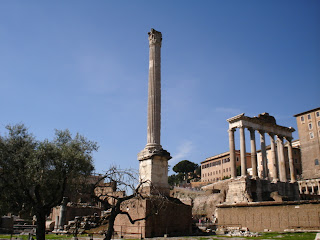Today's photos
1. The Pantheon was dedicated as a church on November 1, 609.
2. The notice inside the Pantheon reminds us of the name of the church.
3. The column of Foca set up in the Roman Forum by Boniface IV.
4. Pius IX, who considered himself a prisoner in the Vatican beginning in 1870.
5. The tomb of Victor Emanuel II in the Pantheon.
6. A historic photo of the signing of the Lateran Treaty on February 11, 1929, by Cardinal Gasparri and Benito Mussolini.
ALL SAINTS DAY: NOVEMBER 1
Today, November 1, the Christian world celebrates All Saints Day, which is also a national holiday in Italy: Tutti i Santi. This liturgical feast day is over 1,400 years old, but it has not always been celebrated on November 1. For the first 800 plus years of its existence, the commemoration of all the saints took place on May 13. The feast day was created and the day, Mary 13, was chosen by Pope Boniface IV (608-615). Of course he had a special reason for doing so. This was the day in 609 that Boniface consecrated the Pantheon (photo 1), transforming it from a pagan temple dedicated to all the gods, into a Christian church dedicated to the Virgin Mary and all the Christian martyrs. For the occasion the Pope had a large number of martyrs' bones brought from the catacombs and entombed beneath the main altar. To this day the Pantheon bears the Christian name of Santa Maria ad Martyres, St. Mary at the Martyrs (Photo 2). The martyrs would represent all the saints, hence the name of the feast day.
All of this was possible thanks to the generosity of Foca the Emperor of the East who, eager to ingratiate himself with the people of Rome, donated the Pantheon to the Pope in 609. Boniface turned it into a church, thus going down in history as the man who saved for posterity one of the most magnificent ancient Roman monuments in existence.
A curiosity
Shortly after this unusual donation, Boniface, not to be outdone by Foca's generosity, ordered that a column be erected in the Roman Forum in honor of the Emperor, to thank him for his gift. Still standing today, although without the statue of Foca which once stood at its peak, the Column of Foca (Photo 3), was the last monument to be erected in the Roman Forum. (For more about the Pantheon see The Sights of Rome, Chapter 16, The Pantheon).
So beginning in 609 the feast of All Saints began to be celebrated on May 13. The date was changed to November 1 in 1475 by Pope Sixtus IV (1471-1484). We are not exactly sure why Sixtus chose this day, but some scholars speculate that the reason may have been to make the observance coincide with the traditional Anglo-Saxon and Central European celebration of the beginning of winter.
----------------------------------
This date, November 1, is important for two other significant events which concern the relationship between the Holy See and the Italian State. On this date in 1870, Pius IX (Photo 4), issued the encyclical Respicientes, in which he declared null and void the Italian occupation of the territories of the Papal State. He excommunicated King Victor Emanuel II and all those who had participated in the seizure. He refused to recognize the legitimacy of that State and forbade Catholics, under pain of excommunication, to participate in any activities of the State, including voting.
A curiosity
The excommunications were rescinded by Pius as the King lay on his deathbed. He died on January 9, 1878 in the good graces of the Church and was given burial in the Pantheon (Photo 5). The Pope would follow him in death less than a month later on February 7, 1878, ending a thirty-two year papacy, the longest in history.
Fifteen years after the encyclical of Pius IX, another papal encyclical, Immortale Dei, was issued by his successor, Leo XIII (1878-1903) on November 1, 1885. This document opened the door to a change in the standoff between the Italian State and the Holy See. The Pope declared that under certain conditions it could be just for Catholics to participate in activities of the State. It does not sound like much to us today, but considering the times, this was an important first step toward a full participation of Catholics in the political life of Italy. The process of reconciliation between Church and State would not be fully accomplished until February 11, 1929 when the Lateran Treaty was signed (Photo 6) by the two parties. At the historic signing in the papal Lateran palace Italy's Prime Minister, Benito Mussolini, represented King Victor Emanuel III and the Vatican Cardinal Secretary of State, Pietro Gasparri, represented Pius XI. But we should remember that it was that encyclical by Leo XIII on All Saints Day of 1885 which began the slow process of reconciliation between Church and State.
Such a situation as existed from 1870 to 1929 between the Holy See and the Kingdom of Italy seems impossible to us in 2012. Today the Pope and the President exchange best wishes several times every year on the occasion of birthdays and anniversaries. When the Pope travels out of Italy the President often goes to the airport to see him off or to welcome him back. Meetings between the two men have taken place both in the Vatican and in the Quirinal Palace in Rome. Often a strong personal friendship develops between a pope and a president. In the late 1970s and early 1980s, an athletic Pope John Paul II and an equally athletic President Sandro Pertini went snow skiing together! How times have changed!






0 comments:
Post a Comment